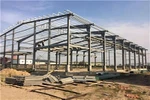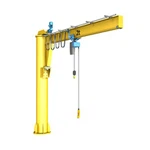Launching Gantry
A launching gantry, also known as a launching girder or bridge launcher, is a specialized piece of construction equipment used in the building of elevated structures such as bridges and viaducts. It is designed to support and move precast concrete segments or other structural elements into position, allowing for the gradual construction of a structure over a span. The launching gantry is particularly useful in situations where traditional construction methods may be impractical or time-consuming.

Key Features
● Structure and Design:
■ Launching gantries typically consist of a horizontal bridge-like structure supported by vertical legs or towers at each end.
■ The gantry is often designed to be self-supporting, allowing it to move along the completed portion of the structure as construction progresses.
● Lifting and Positioning:
■ The main function of the launching gantry is to lift and position precast segments or other construction elements with precision.
■ It often incorporates lifting mechanisms, such as hydraulic jacks or winches, to raise the construction elements into place.
● Horizontal Movement:
■ Launching gantries are mounted on tracks or wheels, allowing them to move horizontally along the completed portion of the structure.
This horizontal movement enables the gantry to extend the structure gradually, segment by segment.
● Versatility:
■ Launching gantries are versatile and can be adapted to different construction scenarios.
■ They can be designed for use in various bridge types, including cable-stayed, segmental, and box girder bridges.
● Time and Cost Efficiency:
■ The use of a launching gantry can significantly reduce construction time and costs.
■ Precast segments can be manufactured off-site and transported to the construction site, minimizing on-site labor and speeding up the overall construction process.
● Safety Considerations:
■ Safety features such as load monitoring systems, stability controls, and fail-safe mechanisms are often integrated to ensure the safety of the construction crew and equipment.
● Environmental Impact:
■ Launching gantries contribute to a reduced environmental impact by minimizing disruption to the surrounding area during construction.
● Automation and Control:
■ Some modern launching gantries are equipped with advanced automation and control systems, allowing for precise positioning and efficient construction management.

Parts & Components
A launching gantry is a complex piece of construction equipment with various parts and components that work together to facilitate the construction of elevated structures. The specific design and components can vary based on the type of bridge or viaduct being constructed and the manufacturer of the launching gantry.
- Main Beam or Girder: The main beam is the horizontal structure that spans the gap between the completed portion of the structure and the point where construction is ongoing. It provides support for the lifting and positioning mechanisms.
- Vertical Towers or Legs: These are the vertical supports that hold the main beam in place. They are usually positioned at each end of the gantry and are designed to provide stability during construction.
- Lifting Mechanism: The lifting mechanism is responsible for raising and lowering the precast segments or construction elements. It may include hydraulic jacks, winches, or other lifting devices.
- Horizontal Movement System: Launching gantries are equipped with systems that allow them to move horizontally along the completed portion of the structure. This can involve tracks, wheels, or other mechanisms for controlled movement.
- Casting Bed or Deck: The casting bed is the platform where precast segments are assembled and prepared for lifting. It is usually located at the end of the completed portion of the structure.
- Control Cabin: The control cabin is where the operator oversees and controls the movements and operations of the launching gantry. It houses the control panel and may include monitoring systems for safety and efficiency.
- Safety Systems: Various safety features are integrated into launching gantries, including load monitoring systems, stability controls, emergency stop mechanisms, and fail-safe systems to ensure the safety of personnel and equipment.
- Power System: Launching gantries are powered by electric or hydraulic systems. This includes motors for movement, lifting, and other operations. Power units are often located on the gantry or on a separate power car.
- Counterweight System: Some launching gantries use counterweights to balance the load during lifting and movement. This helps optimize stability and control.
- Automation and Control Systems: Modern launching gantries may feature advanced automation and control systems. These systems ensure precise positioning, synchronized movements, and efficient construction management.
- Auxiliary Equipment: Depending on the specific requirements of the construction project, launching gantries may be equipped with additional tools and equipment, such as concrete placement systems, formwork, and curing systems.

Product Parameter

Sketch


Advantages
The use of launching gantries in construction projects offers several advantages, making them a preferred choice for building elevated structures such as bridges and viaducts. Here are some key advantages of using launching gantries:
- Efficient Construction Process: Launching gantries facilitate an efficient and streamlined construction process. Precast segments or construction elements can be prepared off-site, allowing for faster assembly and installation on-site.
- Reduced Construction Time: The modular and precast nature of construction using launching gantries significantly reduces the overall construction time. The ability to work on multiple segments simultaneously speeds up the progress of the project.
- Cost-Effectiveness: Launching gantries contribute to cost savings by optimizing construction time and reducing the need for extensive on-site labor. The off-site preparation of segments can also lead to cost efficiencies.
- Minimized Disruption to Traffic: When constructing bridges over roads or waterways, launching gantries help minimize disruption to traffic and water navigation. The incremental construction process allows for the gradual expansion of the structure without the need for complete road closures.
- Flexibility in Design: Launching gantries are adaptable to various bridge designs, including cable-stayed, segmental, and box girder bridges. This flexibility makes them suitable for a wide range of construction projects.
- Improved Safety: Safety features are integral to launching gantries. These features include load monitoring systems, stability controls, and emergency stop mechanisms, enhancing overall safety for construction personnel and equipment.
- Environmental Impact Reduction: Launching gantries contribute to a reduced environmental impact by minimizing on-site construction activities. The off-site fabrication of segments decreases noise, dust, and other environmental disruptions.
- Precise Positioning: Modern launching gantries are equipped with advanced automation and control systems, allowing for precise positioning of construction elements. This accuracy ensures that each segment is placed with high precision, contributing to the overall structural integrity of the bridge.
- Adaptability to Site Conditions: Launching gantries can be designed to adapt to specific site conditions, including varying topography and environmental constraints. This adaptability makes them suitable for a wide range of construction environments.
- Reduced Dependency on Weather: Since much of the construction work with launching gantries involves precast elements, there is reduced dependency on weather conditions. This can lead to more predictable construction schedules.

Application
Launching gantries find extensive applications in the construction of elevated structures, particularly in the building of bridges and viaducts. Their unique design and capabilities make them well-suited for various construction scenarios. Here are some key applications of launching gantries:
- Bridge Construction: Launching gantries are widely used in the construction of different types of bridges, including cable-stayed bridges, segmental bridges, box girder bridges, and more. They facilitate the incremental construction of the bridge, allowing for the systematic placement of precast segments.
- Viaducts and Elevated Roadways: In the construction of viaducts and elevated roadways, launching gantries are employed to build the elevated sections gradually. This application is common in urban areas where the construction needs to navigate over existing infrastructure.
- Railway Overpasses: Launching gantries are utilized in the construction of railway overpasses and elevated rail lines. The ability to work incrementally and efficiently is especially advantageous in railway projects where minimizing disruption to existing tracks is crucial.
- Interchanges and Flyovers: Launching gantries are applied in the construction of interchanges and flyovers, helping create elevated intersections for smoother traffic flow. The incremental construction process allows for minimal disruption to ground-level traffic.
- Port and Waterway Crossings: When constructing bridges over ports or waterways, launching gantries are employed to minimize disruption to maritime activities. The ability to extend the bridge gradually is particularly useful in these scenarios.
- Tunnels and Underground Structures: Launching gantries can also be used in the construction of tunnel entrances or other underground structures where a gradual extension is required. This is less common but showcases the adaptability of launching gantries.
- Long-Span Structures: For the construction of long-span structures, such as those found in cable-stayed bridges, launching gantries play a crucial role. They allow for the precise placement of large and heavy precast segments, contributing to the stability and integrity of the structure.
- Urban Infrastructure Projects: Launching gantries are valuable in urban infrastructure projects where space constraints and the need for minimal disruption are significant considerations. Their efficiency in construction and ability to work in confined spaces make them suitable for such environments.
- Highway and Expressway Construction: In the construction of highways and expressways, launching gantries are used to create elevated sections, reducing the footprint of the road and minimizing the impact on surrounding areas.

Production Procedure
- Design and Engineering: The production process begins with the design and engineering phase. Engineers and designers create detailed plans and specifications for the launching gantry based on the project requirements, load calculations, and safety standards.
- Material Selection and Fabrication: Once the design is finalized, materials are selected based on the structural requirements. Common materials include high-strength steel for the main beam and supporting structures. Fabrication involves cutting, welding, and shaping the components according to the design specifications.
- Quality Control: Quality control measures are implemented throughout the fabrication process to ensure that the components meet the required standards. Non-destructive testing methods, such as ultrasonic testing or X-ray inspections, may be employed to check for weld quality and material integrity.
- Assembly of Components: Fabricated components are assembled to create the main structure of the launching gantry. This includes the main beam, vertical towers or legs, lifting mechanisms, horizontal movement systems, and other essential components.
- Installation of Control Systems: Control systems, including automation and safety features, are integrated into the launching gantry. This involves the installation of electronic components, sensors, and the control cabin where the operator will manage the gantry's movements.
- Power System Integration: The power system, whether hydraulic or electric, is integrated into the launching gantry. This includes the installation of motors, pumps, and other components necessary for lifting, horizontal movement, and other operations.
- Testing and Calibration: The assembled launching gantry undergoes comprehensive testing to ensure all components function as intended. This includes calibration of the control systems, load testing, and operational tests to verify the gantry's performance under various conditions.
- Transportation to the Construction Site: Once the launching gantry passes all quality and performance tests, it is prepared for transportation to the construction site. Depending on the gantry's size and design, it may be transported in sections and assembled on-site.
- On-Site Assembly and Commissioning: On-site, the launching gantry is assembled according to the project specifications. This involves erecting the vertical towers, connecting the main beam, and ensuring all components are properly aligned. Commissioning activities include final adjustments, system checks, and safety inspections.
- Training and Handover: Operators and maintenance personnel receive training on the operation and maintenance of the launching gantry. Once training is complete, and all systems are confirmed to be in working order, the gantry is handed over for use in the construction project.

Workshop View





Hot Tags: launching gantry, China launching gantry manufacturers, suppliers, factory
Previous
Bridge Erection Beam LauncherYou Might Also Like
Send Inquiry

























